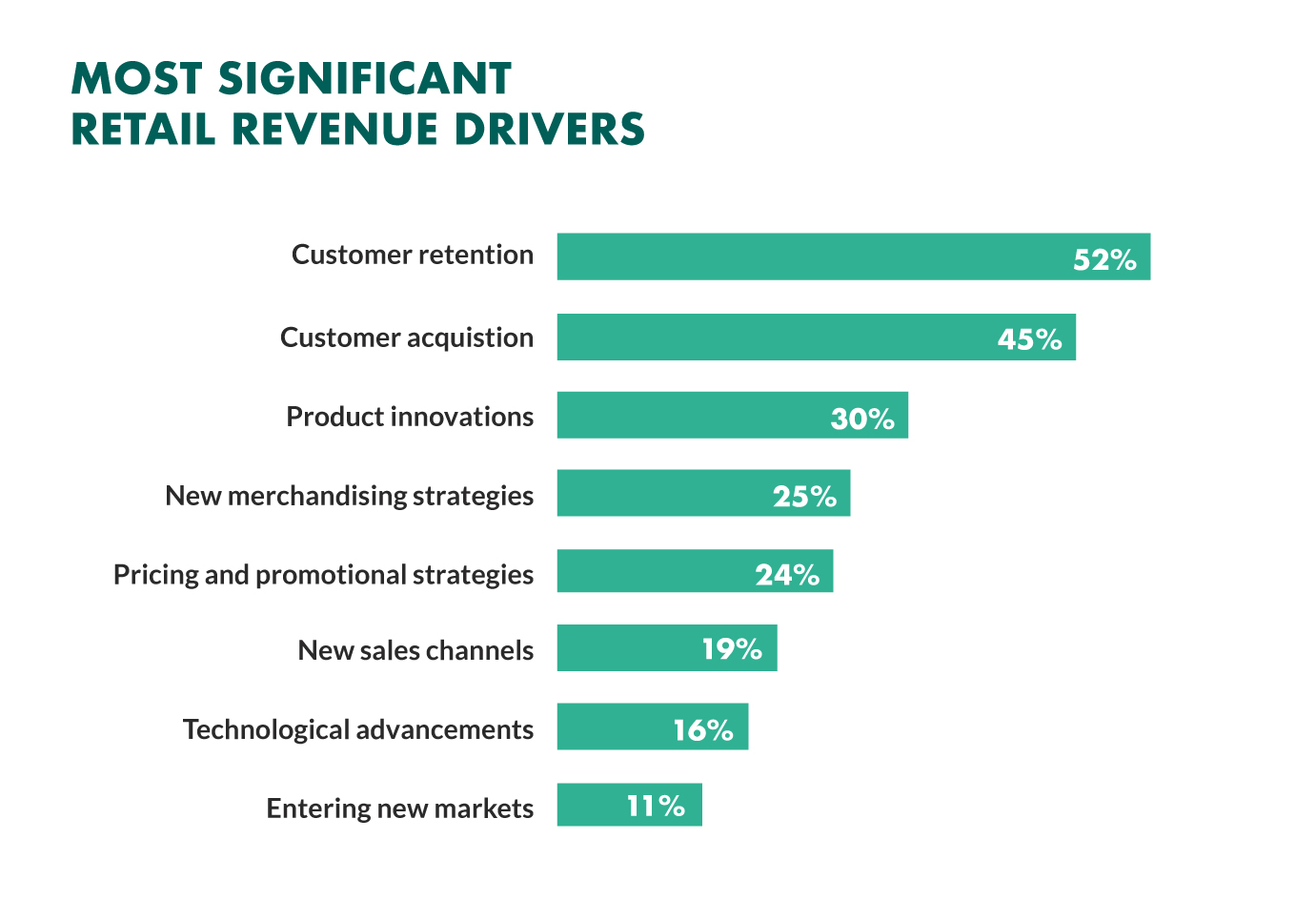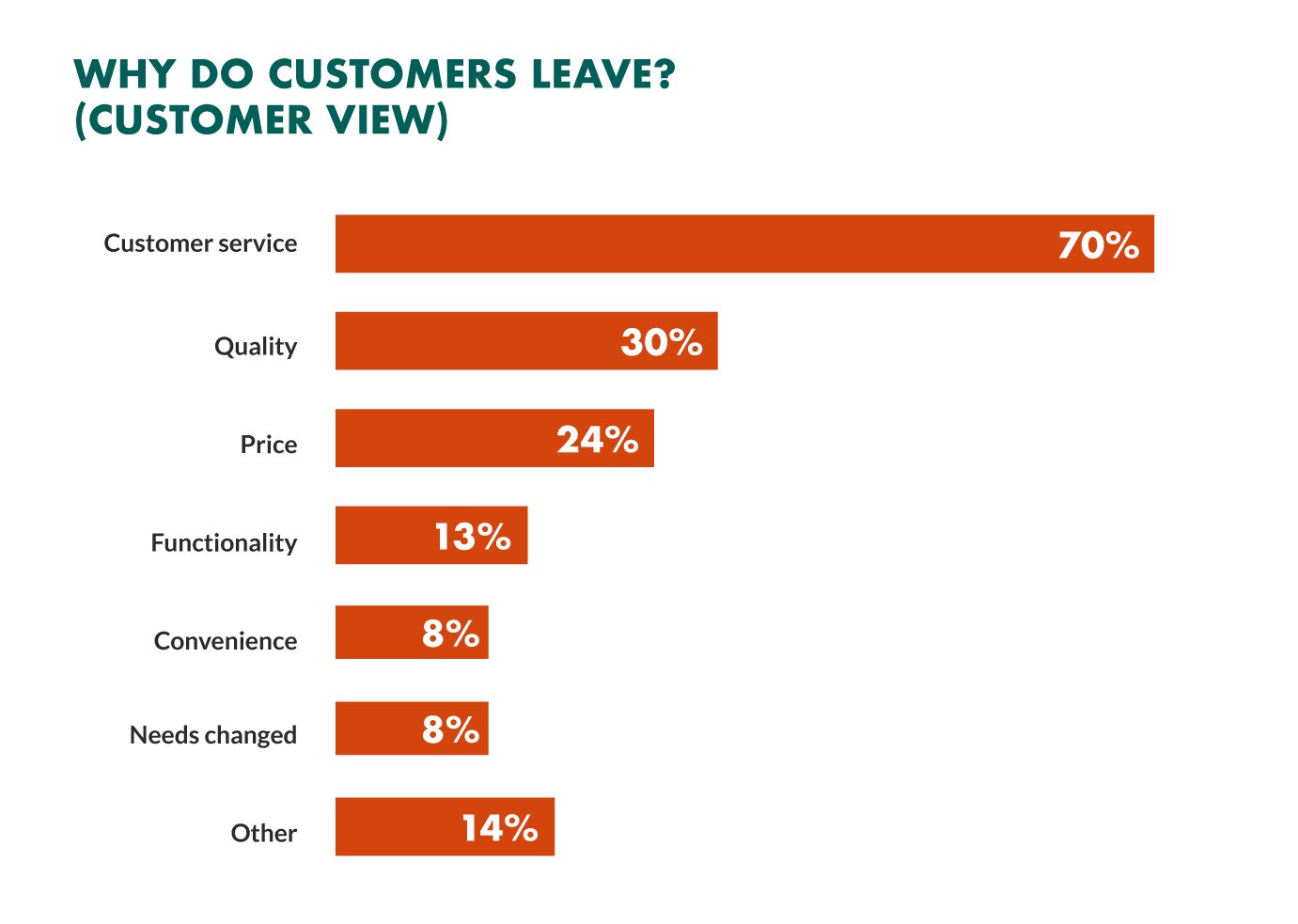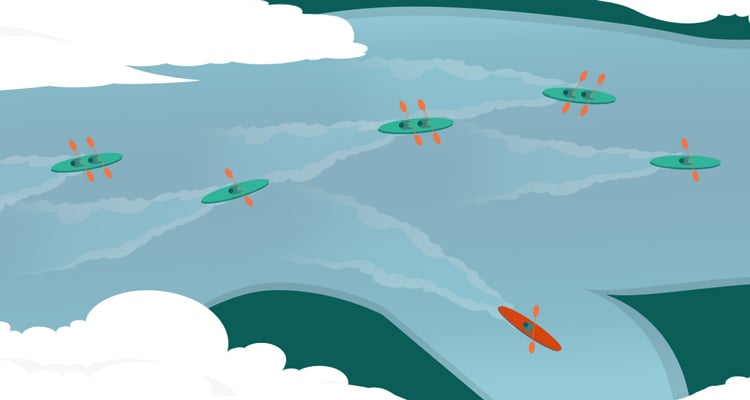There is not a single business in the world that has never lost a customer.
And every business deals with it differently: some immediately start looking for new customers to replace the loss; others throw all their forces at analyzing what went wrong and how to put a lid on others trying to run away.
This problem is called customer churn – the number of customers who leave a company during a given time period.
But why does churn matter so much for businesses in the first place?
Well, the short answer is – because it costs too much to lose customers.
Why does churn matter?
Customer churn is a real headache for many companies, as it shows how good they are at keeping customers by their side.
First, it’s the financial aspect of churn that causes most trouble.
In the US alone, companies are losing $83 billion each year due to customer churn and abandoned purchases!
According to the Forrester, it costs 5 TIMES MORE to acquire new customers than it does to keep the existing ones and it will cost you 16 times more to bring a new customer up to the same level as a current one.
The second reason lies in the fact that the more customers a business retains the more revenue it makes!
For example, the Harvard Business School report claims that on average, a 5% increase in customer retention rates results in 25% – 95% increase of profits. And the lion’s share – 65% of a company’s business comes from existing customers!
The same truths are revealed by KPMG, who found that customer retention is the main driver of a company’s revenue.

Impressive, isn’t it?
But that’s not all.
According to Gartner, a staggering 80% of a company’s future revenue will come from just 20% of its existing customers. Meanwhile, Marketing Metrics claims that the probability of selling to an existing customer is 60-70%, and only 5-20% to a new prospect.

So, it makes perfect sense that focusing on reducing churn is paramount since keeping your customers is profitable!
Yet, not too many companies understand this and, as a result, still struggle in trying to implement a successful churn prevention strategy. So, how do you reduce customer churn?
12 ways to reduce customer churn
No need to panic, there are things that you can do right here and right now to combat customer churn.
To get you started, here are 12 ways you can reduce customer churn.
1. Analyze why churn occurs
Yes, this may sound obvious, but let’s stress it once again: you have to simply find out why customers decided to leave.
The easiest way to do this is to talk to the customer. And by “talk”, I mean really talk: getting your customers on the phone is the best option. This way you can demonstrate that you genuinely care, and you can find out what went wrong instantly.
FACT: 68% of customers leave because they think a company doesn’t care about them.
Don’t go down the lazy path by sending the customers exit surveys; just call them up and ask why they left. This will give you immediate feedback on whether or not your product solves the customers’ problems or causes trouble.
In fact, communicating with the customers does miracles in analyzing churn. And you need to be actively using all channels for that: phone, e-mail, website, chat, and social media. The valuable feedback on how well you serve your customers is just a phone call, an e-mail or a survey away. As simple as that.
2. Engage with your customers
Another way to prevent churn is to actively engage your customers with your product.
Give your customers reasons to keep coming back by showing them the day-to-day value of using your products, by making your products, services, offers, etc. a part of their daily workflow.
So, how can you do it? For starters, provide ample and versatile content about the key functional benefits of your product and offer regular news updates, such as announcements of deals, special offers or upcoming upgrades.
Again, you should engage with your customers on all channels. According to a recent report from Marketo, the most efficient customer engagement channels for B2B companies to reach out to their existing customer base is through email marketing, website content and social media.

Not sure what content to publish, where and when?
Then it’s a great idea to analyze your customers’ journey.
The customer journey gives you a clear picture of all customer interactions across all channels, devices and touchpoints throughout every stage of the customer lifecycle, and be present with the right content at the right place and time.
Another method comes in the form of social listening – the process of finding and contributing to conversations about your company online by seeking out brand mentions, specific keywords or phrases and comments. This will help you keep your finger on the pulse of what’s going on in terms of customer satisfaction.
And, finally, don’t forget about the good-old feedback. For example, ask your new customers what their first impression of using your product was. This will help you better understand the initial impact that your products are making.
3. Educate the customer
This churn-prevention trick naturally flows from the point above.
You have to provide enough good quality educational or support materials, which will help increase retention and reduce churn. Offer free trainings, webinars, video tutorials, and product demos – whatever it takes to make your customers feel comfortable and informed.
In other words, you have to not only to give them the tools that work, but also offer the training on how to use these tools at a maximum profit. In this way you will demonstrate the full potential of your products and services, and ensure that customers have a successful onboarding and implementation.
4. Know who is at risk
The best way to avoid churn is to prevent it from happening in the first place, right?
There is always a group of customers that is more likely to leave than others – so it’s in your best interests to know who is balancing on that dangerous edge. This way you can reach out to them in time to make them stay.
Spotting those who are getting closer to the ‘at-risk’ group is easy. Find out which customers were not contacted for a while. Or maybe they asked for something like a price list, a quote or just more information, and you forgot to follow up on that?
Knowing all this will help you become more proactive in preventing churn.
Also, after analyzing the reasons for churn, you become aware of certain actions, or maybe the lack of actions, that your churned customers made. This knowledge can help you foresee if someone, who is behaving similarly, is likely to leave your company soon.
5. Define your most valuable customers
As sneaky as this might sound, you’d better separate the most valuable customers from the rest and go an extra mile to make sure that at least they are getting what they have signed up for.
Why? Well, let’s be honest, these are the customers you want to keep the most. Valuable customers have to be taken extra care of because they bring in the biggest revenue.
A history of your interaction with the customers can show how deeply they are involved at each stage, whether they had any problems with the product, and whether these issues were dealt with.
So, what you can do is segment your customers into groups of profitability, readiness to leave, and their likelihood to positively respond to your offer to stay. In this way you can better predict customer churn.
6. Offer incentives
Another advisable tip is to offer incentives, such as discounts and special offers, to those customers who were identified as likely to defect.
But! Beware that you have correctly evaluated whether offering an incentive is beneficial for you. That means you have to be sure that the costs of your retention program do not outweigh the profits to be gained from the customers you intend to save.
Bottom line – you should not be wasting money on customers who are not likely to bring you substantial revenue.
7. Target the right audience
No matter how sophisticated your retention tricks are, they may all go down the drain if you are attracting the wrong audience.
What I mean here is – if your first interaction with the customer is about “free” and “cheap”, then you risk attracting people who are not looking for the value you provide. These “freebie” collectors are the most likely to leave.
It’s better to target those who appreciate the long-term value of products and see investing in good quality as an advantage. You’d better focus on those.
8. Give better service
You anticipated this tip earlier, didn’t you?
Yes, it is the most obvious method of keeping customers by your side. In fact, poor customer service is the leading case of customer churn. According to a Customer Experience Impact Report by Oracle, the two main reasons of why customers leave the company are incompetent and rude staff and unbearably slow service.
Churn because of poor service stands at 70%, according to Forum Corporation’s research.

By all means, do not underestimate the detrimental effect of poor customer service!
Studies show that 58% will never use a company again after 1 negative experience, and 48% who had negative experience will tell 10+ people about it.
And we are not talking here about really bad service. Sometimes an average customer experience, or what can be called a “meh” experience, is a trigger for churn. You simply showed nothing to hook that customer on.
So, make sure that you provide “best in class” customer service that makes customers, above all, happy.
9. Pay attention to complaints
Complaints are like tips of the icebergs – they suggest that the bigger part of the problem is hidden from the view.
Did you know that 96% of unhappy customers don’t complain, and 91% of those will simply leave and never come back?

Are you also aware that it takes only 1 negative experience to make 32% of customers stop doing business with a brand they once loved?
So, you’d better take complaints seriously and act on them, and in this way prevent customer churn, because, as Strauss & Seidel claims, dissatisfied customers whose complaints are attended to are more likely to remain loyal, and even become advocates, than other average customers.
10. Make your best people deal with cancellations
To save a customer who is about to churn is certainly not mission impossible. But you will have to call on your best sales experts to achieve good results in keeping them.
Find out who your best, most vocal and convincing sales reps are and give them the task to talk to those who decided to leave, and in this way – prevent customer churn. At this point, you can certainly make use of their charisma and experience in dealing with difficult situations and dissatisfied customers.
Sometimes it only takes a good listener who is eager to walk in the customers’ shoes to change things around. According to the customer satisfaction survey conducted by Customer Service Group, the majority of respondents said that being heard and respected are more important than having their issue resolved.
11. Flaunt your competitive advantages
How different are you from your competitors? What makes you stand out? What will your customers lose if they decide to quit?
Answering these questions will help you define your competitive advantages and then flaunt them more. Competitive advantages are like honey that glues your customers to you. Analyze what it is that you do better or what makes you unique. Now think – do your customers know about it?
If not, it might be high time you told them.
12. Offer long term contracts
Finally, how about extending your customers’ commitment? Instead of the month-to-month contracts, try offering a longer subscription model. In such a way your customers will have enough time to implement the product and see the benefits of using it. And once they see the benefits, they are more likely to commit to the product.
Conclusion
Now that we have established that you simply cannot afford to lose customers, it is better to focus on being a keeper. That means that your customers have to clearly see why it is better to keep you and stay with you instead of leaving.
And you’d better be proactive in how you prevent customer churn by creating the conditions in which customers would clearly see and make use of the benefits your products offer.
To stay motivated, just keep in mind that 82% of companies claim that retention is cheaper than acquisition and even a small 2% increase in retention can lower costs by as much as 10%.
It’s also important to realize that the main reasons of churn have nothing to do with the product, but mostly comes down to poor customer service!
All in all, keeping your customers is not magic. It all boils down to analyzing the reasons behind churn and then acting on them. Communicate with customers and involve them with your products, improve your customer service levels and make sure they see what they are gaining if they stay with you, rather than stray away from you.
Making your customers stay requires 3 main things: your full attention + consistently awesome customer experience + personalized service. This is where CRM software can come in handy.
If your current CRM system does not help you keep your customers and increase loyalty – then it’s time you asked for a free demonstration of SuperOffice CRM – a system that offers a 360 overview of your relationships with customers and consolidates all sales, marketing and customer service activities into a single, digital profile.
